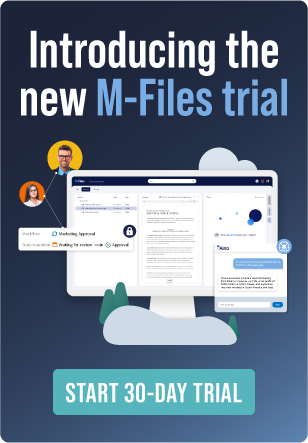What Organizations Should Know About Getting Started With Workflow Automation

Antti Nivala, Founder and CEO, M-Files
January 25, 2023
In today’s business climate, things are moving faster than ever. Organizations are now tasked with managing and protecting more information, and speed and efficiency have taken over as two of the top priorities that enable organizations to keep up with the pace of business.
However, many businesses still rely on the legacy approaches to managing that influx of information, such as the multistep process of mailing, waiting and responding before a contract can be finalized. Organizations today should instead consider solutions that enable them to increase productivity, improve efficiency and deliver significant business impact. One way in which organizations can achieve these goals is by incorporating automation into their existing workflows.
Workflow automation automates everyday work tasks according to predetermined business rules to increase consistency, improve efficiency and achieve faster throughput. It helps make real-world processes simpler to follow and more repeatable. Workflow automation rarely makes a process fully automated, but the streamlining and elimination of mechanical steps, and the guidance it provides, can have a meaningful impact on the bottom line.
For example, here are a few of the benefits that can be expected from workflow automation:
Increased Productivity
Automating specific tasks around client information can help reduce some of the mundane, time-consuming tasks that often lead to unnecessary cycles. Through workflow automation, employees are instead guided through the process automatically, so they don’t have to physically remember what comes next or spend countless minutes searching for that long-lost document.
When an employee starts a new client project, for example, workflow automation can automatically provide the background context, as well as pre-fill templates for project deliverables. Similarly, when the deliverables are being finalized, workflow automation can ensure all the required reviews and approvals are completed before sharing the final outcome.
Feeling Of Safety With workflow automation, existing processes can be set up to be intuitively followed so that work is done on time and information is proactively delivered to the right destination. The correct workflows, security controls, records management and approvals are applied to information automatically, helping to ensure that employees no longer need to be fearful of making mistakes.
Strong Compliance Standards
Managing information is a critical part of achieving compliance, especially in highly regulated industries.
Workflow automation can automatically ensure policies are enforced, documents are secured and files are created, stored, used and retained in ways that comply with regulatory requirements. Workflow automation can help make sure projects move through all required steps appropriately and all rules are followed to meet compliance requirements, which can help ensure only the right people have access to sensitive information.
Improved Audit Trail
Workflow automation can also enable organizations to track information version history and immediately view an audit trail. Every step is documented automatically with a date and time stamp. Organizations gain instant audit trail visibility across all documents to ease control oversight and show evidence of compliance.
The traceable records provided by automated workflows provide proof that a required process is being followed, such as access only being granted to specific individuals, which is valuable to meet stringent external audit requirements. For example, an ISO-compliant company that has implemented workflows in a quality management system (QMS) can prove that they are processing corrective and preventative actions properly.
How To Get Started With Workflow Automation
As companies continue to add additional tools to their technology stack—from ERP (enterprise resource planning) to CRM (customer relationship management) and HR (human resources) systems—it’s important to ensure efforts aren’t being duplicated across multiple systems. Workflow automation can help be the practical tool that glues everything together.
To begin your workflow automation journey, it’s important to remember it’s OK to start small and grow. Begin with a process that won’t be overly complex to automate and use that as a means for validating the solution, easing change management and learning how to best implement automation in your organization.
Think of a process that isn’t mission critical, so if there are problems or delays with the implementation, the effects are minimal. A process that is limited in scope with respect to the organization (i.e., a department-specific process, rather than companywide) is often a good starting point. Starting with a process limited in scope can also enable more efficient testing and iterating within a smaller group to gain the most actionable feedback.
Once automating noncritical processes have been mastered, it’s easier to build on that by automating additional and more complex solutions. Starting small enables you to better understand and define your goals for implementing an automated solution so that you can ensure the automation is improving processes over time and providing the desired value.
When incorporating workflow automation, the biggest hurdle is typically the fact that people are so used to manually approving and moving information, that they’ve turned this into a key part of their job versus truly understanding it’s simply busy work. Having the discussions with employees to help them understand how workflow automation can help them focus on higher value work, instead of spending endless cycles on unnecessary manual labor, is a key part of a successful workflow automation strategy. Humans remain the biggest hindrance of success if they don’t understand the potential value from the onset.
With the massive increase in the amount of data that organizations generate, process and collect from myriad data sources, workflow automation can enable businesses to keep pace with constantly changing environments. By starting small and communicating the benefits with employees upfront, workflow automation can increase efficiency, productivity and compliance efforts—but only if approached in a well-planned manner.
Forbes Technology Council is an invitation-only community for world-class CIOs, CTOs and technology executives. Do I qualify?
Follow me on Twitter or LinkedIn. Check out my website.
Antti Nivala is Founder and CEO of M-Files, a global leader in information management. Read Antti Nivala’s full executive profile here.




